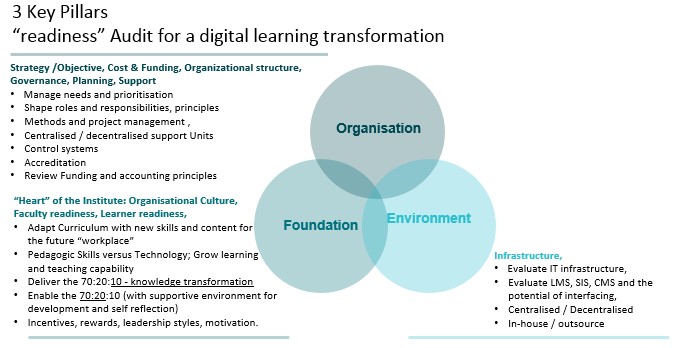We still face great ambiguity between really understanding what blended and online learning means for an educational body. What significance does digital education have on learning outcomes, the IT infrastructure, the financial model, program quality, accreditation, validation of examination, student data, the role of the teacher?
Most advocates of eLearning in higher education explicitly or implicitly link eLearning to the need for institutional transformation through new approaches to teaching and learning and new organizational models (Bates and Sangra, 2011; de Freitas and Oliver, 2005). The pressing digital transformation question is, how will we manage and plan the critical challenge of change management and the need to consider how organizational change is conceptualized.
Whether a clear project plan with different stages of development and implementation or a more generic rationale for digital transformation is needed really depends on the scale and stage of the digital transformation. Higher education institutions typically move through five different stages as they introduce and ultimately integrate eLearning as a strategic plan: Lone Rangers, Encouragement, Chaos, Planning, & Sustainability, (Bates, 2007). It is of utmost importance for an institute to understand on various organizational levels, at which of these five “maturity stages” they are. The more advanced the stage the more institutional support and integration in the overall management is essential; conversely, in very early stages of eLearning development, efforts of individual faculty and the initiates on operational level will do. “Simple” early digital activities in learning should not be overly controlled or managed, rather they should be left as a phase of discovery where new ideas can be piloted and learnt from, with a view to promoting the possibility of strategic change.
INVEST IN EDUCATION TOOLKIT
With this 10-step process, you will have all the tools you need
to master the critical areas of a successful school.
5 questions that need to be addressed at the end of the 3rd stage (Chaos)
- Do we have a compelling vision for eLearning and does our vision direct new and better learning outcomes, greater flexibility for students, and increased cost-efficiencies or a better positioning in the market?
- Do we have our vision for flexibility aligned with a strategic plan that recognizes the importance of digital transformation and do we have concrete prerequisites for the implementation of eLearning?
- Is this vision and institutional strategy for digital transformation shared and supported by all members of the executive team? Above all, is the support long-term, beyond the terms of the current executive (since it will take many years to fully implement a digital learning strategy and the ongoing changes in technology require constant planning and managing)?
- Is our digital transformation integrated with overall educational planning? Particularly with the academic program quality, budgeting and financial planning? Is it embedded in our student support infrastructure, and in the marketing and sales / enrollment / intake strategy?
- Are our teachers and staff directly involved in the visioning and strategic processes for this digital transformation? Is there full transparency of what is expected from everyone?
One of the first steps to make progress in planning the digital ambition is to measure the institutional digital transformation “readiness”. Key readiness measurements are: costs and funding, IT infrastructure, organizational culture, faculty readiness, learner readiness, planning & organizational structure (Bates, 2005).
Internal investigations and audits are necessary to measure the readiness and determine the capacity for the planning and development of digital goals. The identification of the context and situation of the institute will determine how much planning, change and reorganization is necessary. Based on the comprehensive comparisons of multiple “ready ness” models from Springer (2016), we created a model with three key pillars to determine the e-learning readiness of an institute.
The organization
This pillar takes the management, leadership, structure, and the organizational responsibilities and disciplines into account. It relates to “how” an institute is organized. This will combine outcomes of various surveys assessing the Organizational Readiness (consisting of 5 sub categories; Cost and Funding, Organizational Structure, Planning, Governance, Roles and Responsibilities).
The foundation
This pillar represents the heart of the institute that keeps it running – its faculty, students, and culture. It considers the people who participate in the institute. The Institutional Foundation Readiness can be measured by a combination of three sub-surveys including the organizational culture (Bergquist and Pawlak, 2008), faculty readiness (IT & pedagogical skill set), students/learner readiness (demographics, learner readiness, learner demand).
The environment
The technological landscape of the institute. This pillar focuses on the current infrastructure (the “what”) of the organization. A satisfactory environment enables the use or implementation of hardware, online tools, software, LMSs, resources and technology support. The technology readiness can be assessed by two surveys that evaluate IT Infrastructure and internal support.
Combining the results of three overlapping yet complementing key pillars may measure how ready the institute is for online learning on all levels.

Figure 2. ELearning Readiness Pillars
Each key pillar varies in importance depending on the size of the organization, scale of the digital transformation (E-Learning goals), and the current context of the institute. In the infant stages of digital Learning transformation it seems compelling to focus mainly on the Foundation Pillar, and taking the readiness of the faculty, students and the culture into consideration before moving to the more complex layers of the Environment and Organization readiness.
Within each stage of “digital transformation readiness”, different questions arise and they require adjustments in the project planning and implementation in order to reach the desired digital change. The main question remains: are we ready for the stage we are in?
Despite the overall pressure on institutes for missing out on this digital transformation in education, “Not being ready” leads to wrong decision making, a waste of time and money, which in retrospect leads to (re) adjusting your initial objectives to the poor results putting you straight back to stage 3, Chaos.





